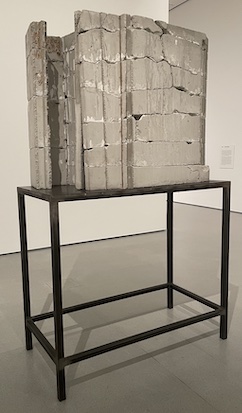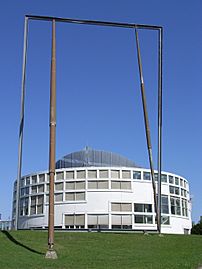Isa Genzken facts for kids
Quick facts for kids
Isa Genzken
|
|
|---|---|

Genzken in 2009
|
|
| Born | 27 November 1948 Bad Oldesloe, Schleswig-Holstein, Germany
|
| Education | Kunstakademie Düsseldorf, Hamburg University of Fine Arts and Berlin University of the Arts |
Isa Genzken (born 27 November 1948) is a German artist known for her unique sculptures and art installations. She uses many different materials like concrete, wood, and fabric in her work. She also creates art using photography, video, film, and collages. Isa Genzken lives and works in Berlin, Germany.
Contents
Early Life and Art Education
Isa Genzken, whose full name is Hanne-Rose Genzken, grew up mostly in the small German cities of Bad Oldesloe and Hamburg.
She studied fine arts and art history at the Hamburg University of Fine Arts from 1968 to 1971. She continued her studies at the Berlin University of the Arts from 1971 to 1973. To help pay for her schooling, Genzken worked as a model. In 1973, she moved to the Arts Academy Düsseldorf. There, she also studied art history and philosophy at the University of Cologne.
After finishing her studies in 1977, Genzken taught sculpture at the academy. She later moved to Cologne in 1983. In 1993, Genzken moved back to Berlin.
Genzken has worked in studios in Düsseldorf and Cologne. She also spent some time working in the United States, in Lower Manhattan and Hoboken, New Jersey. Today, her studio is in Berlin.
Exploring Isa Genzken's Artworks
Isa Genzken is mainly known for her sculptures, but she has created art in many different ways. This includes photography, films, videos, drawings, paintings, collages, and even music. Her art style is influenced by movements like Constructivism and Minimalism. She often explores ideas about modern buildings and everyday objects in her work.
Genzken's art is always changing, making her work exciting and unpredictable. She uses materials like plaster, cement, building parts, photos, and everyday items to build structures. These structures sometimes look like modern ruins. She also uses mirrors and shiny surfaces to make viewers feel like they are part of her art. Genzken often places her sculptures in ways that make people move around them, creating a special experience.
Early Sculptures and Photography
In the 1970s, Genzken started making sculptures from wood. She carved these into interesting geometric shapes. In her photo series Hi-Fi-Serie (1979), she used pictures from advertisements for stereo players.

In 1980, Genzken helped design the König-Heinrich-Platz underground station in Duisburg, which was finished in 1992. From 1986 to 1992, she created sculptures using plaster and concrete to explore ideas about buildings. These sculptures were made from layers of concrete with rough openings, like windows or doorways. Later, she made sculptures from epoxy resin that looked like parts of buildings, such as columns or lamps.
In 1990, she placed a steel frame sculpture called Camera (1990) on a rooftop in Brussels. This frame offered a special view of the city below. In 2000, she created a series of architectural models that were roughly put together. Later, in her series New Buildings for Berlin, shown at Documenta 11, Genzken imagined new glass high-rise buildings for Berlin.
Collages and Public Art
The project called Der Spiegel 1989-1991 is a series of 121 black and white photographs. Genzken chose and cut these images from the German news magazine Der Spiegel. Each picture is glued onto white card and framed. The dates in the titles give clues about her ideas.
Her paintings of hanging hoops, called MLR (More Light Research) (1992), look like gymnastics equipment frozen in time.
Starting in 1995, while in New York, Genzken created a three-part collage book. It was titled I Love New York, Crazy City (1995–1996). This book was filled with souvenirs from her visits, including photos of buildings, snapshots, maps, hotel bills, and concert tickets.

One of Genzken's most famous works is Rose (1993/7). This is a large public sculpture of a single long-stemmed rose made from stainless steel. It stands eight meters tall at the Leipzig fairgrounds. Her similar sculpture, Rose II (2007), was placed outside the New Museum in New York in November 2010.
Genzken has also made several films, including Zwei Frauen im Gefecht (1974), Chicago Drive (1992), Meine Großeltern im Bayerischen Wald (1992), and the video Empire/Vampire, Who Kills Death (2003).
Later Works and Installations
Since the late 1990s, Genzken has been making sculptures and panel paintings using materials from DIY stores. She also uses photographs and newspaper clippings. She often chooses materials that show her works are temporary.
She is very interested in city spaces. She creates detailed and sometimes unsettling installations using mannequins, dolls, photos, and various found objects. Her New Buildings for New York are put together from plastic scraps, metal, and even pizza box cardboard.
The artworks from her Empire/Vampire, Who Kills Death series were created after the events of September 11. These sculptures combine found objects like action figures, plastic containers, and other everyday items. They are arranged on stands to look like scenes after a disaster. Elefant (2006) is a tall sculpture made of hanging blinds decorated with plastic tubes, foil, fake flowers, fabric, and tiny toy soldiers. For her installation Oil at the 2007 Venice Biennale, she turned the German Pavilion into a unique and thought-provoking art space.
Genzken has often worked with the art dealer David Zwirner. She had five solo exhibitions with him, starting in 2010. Her "tower" sculptures, inspired by her interest in buildings and city skylines, were part of her exhibitions. These vertical structures are made from materials like fiberboard, mirror foil, and spray paint.
Isa Genzken's Influence on Art
Isa Genzken's art has had a big impact on the art world. She is known for creating sculptures from many different materials. These include wood, plaster, concrete, steel, epoxy resin, and even everyday kitchen items, as seen in her "Babies" series from 1997. Genzken helped redefine what sculpture could be. Her work encouraged and expanded the art of sculpture. Her art often challenges ideas and makes viewers think in new ways. Her sculptures are known for creating illusions and sparking the imagination.
Art Exhibitions
Isa Genzken's first solo art show was in 1976 at the Konrad Fischer Gallery in Düsseldorf. Her first exhibition with Galerie Buchholz was in 1986 in Cologne. A major show called "Isa Genzken: Retrospective" was held at the Museum of Modern Art in New York from November 23, 2013, to March 10, 2014. This exhibition then traveled to the Museum of Contemporary Art Chicago and the Dallas Museum of Art.
Art Collections
Genzken's art can be found in many important art collections around the world. Some of these include:
- The Nationalgalerie, West Berlin
- Staatsgalerie Stuttgart
- Stedelijk Van Abbemuseum, Eindhoven
- Rijksmuseum Kroller-Muller, Otterlo
- The Museum of Modern Art, New York
- Carnegie Museum of Art, Pittsburgh
- The Generali Foundation, Vienna
- The Hirshhorn Museum and Sculpture Garden, Washington, D.C.
- The Kemper Art Museum, St. Louis
- The Museum Ludwig, Cologne
- The Museum Frieder Burda, Baden-Baden
- The Van Abbemuseum, Eindhoven
- The Stedelijk Museum, Amsterdam
- Ruby City, Linda Pace Foundation, San Antonio, TX
- The Rose III sculpture in Zuccotti Park, NYC.
Awards and Recognition
Isa Genzken has received several awards for her artistic achievements:
- In 2002, she won the Wolfgang-Hahn-Prize from the Museum Ludwig in Cologne.
- In 2004, she received the International Art Prize (Cultural Donation of SSK Munich).
Gallery
-
Spiegel (1991), installed in Bielefeld, Germany
See also
 In Spanish: Isa Genzken para niños
In Spanish: Isa Genzken para niños
- List of German women artists


